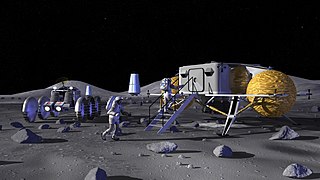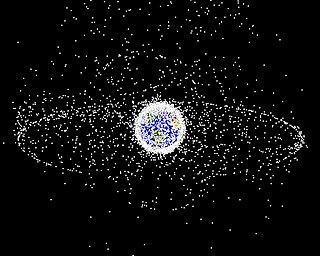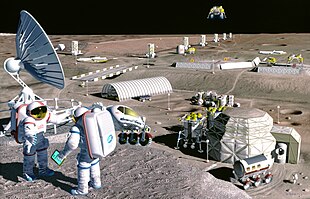
Space exploration is the use of astronomy and space technology to explore outer space. While the exploration of space is currently carried out mainly by astronomers with telescopes, its physical exploration is conducted both by uncrewed robotic space probes and human spaceflight. Space exploration, like its classical form astronomy, is one of the main sources for space science.

Space colonization is the use of outer space for colonization, such as permanent habitation, exploitation or territorial claims. Extraterrestrial colonization is its broader form, including the use of celestial bodies, other than Earth, for colonization.

The Outer Space Treaty, formally the Treaty on Principles Governing the Activities of States in the Exploration and Use of Outer Space, including the Moon and Other Celestial Bodies, is a multilateral treaty that forms the basis of international space law. Negotiated and drafted under the auspices of the United Nations, it was opened for signature in the United States, the United Kingdom, and the Soviet Union on 27 January 1967, entering into force on 10 October 1967. As of March 2024, 115 countries are parties to the treaty—including all major spacefaring nations—and another 22 are signatories.

The Vision for Space Exploration (VSE) was a plan for space exploration announced on January 14, 2004 by President George W. Bush. It was conceived as a response to the Space Shuttle Columbia disaster, the state of human spaceflight at NASA, and as a way to regain public enthusiasm for space exploration.

Space law is the body of law governing space-related activities, encompassing both international and domestic agreements, rules, and principles. Parameters of space law include space exploration, liability for damage, weapons use, rescue efforts, environmental preservation, information sharing, new technologies, and ethics. Other fields of law, such as administrative law, intellectual property law, arms control law, insurance law, environmental law, criminal law, and commercial law, are also integrated within space law.
The Agreement Governing the Activities of States on the Moon and Other Celestial Bodies, better known as the Moon Treaty or Moon Agreement, is a multilateral treaty that turns jurisdiction of all celestial bodies over to the participant countries. Thus, all activities would conform to international law, including the United Nations Charter.

Asteroid mining is the hypothetical extraction of materials from asteroids and other minor planets, including near-Earth objects.

The following outline is provided as an overview of and topical guide to space exploration.

NASA proposed several concept moonbases for achieving a permanent presence of humans on the Moon since the late 1950s. Research and exploration of the Moon has been a large focus of the organization since the Apollo program. NASA's peak budget was in 1964-1965, when it comprised 4% of all federal spending in service of the Apollo Moon landing project. Though lunar landings ever since the conclusion of the Apollo program in 1972 have ceased, interest in establishing a permanent habitation on the lunar surface or beyond low Earth orbit has remained steady. Recently, renewed interest in lunar landing has led to increased funding and project planning. NASA requested an increase in the 2020 budget of $1.6 billion, in order to make another crewed mission to the Moon under the Artemis program by 2025, followed by a sustained presence on the Moon by 2028. A crew was selected for the planned crewed mission, Artemis II, in April 2023.

A moonbase, lunar base, or lunar colony is a facility on or below the surface of the Moon, enabling human activity on the Moon. As such, it is different from a lunar space station in orbit around the Moon, like the planned Lunar Gateway of the Artemis program. Moonbases can be for robotic or human use, in both cases not necessarily including lunar habitation facilities.
Space-based economy is economic activity in outer space, including asteroid mining, space manufacturing, space trade, construction performed in space such as the building of space stations, space burial, and space advertising.

The politics of outer space includes space treaties, law in space, international cooperation and conflict in space exploration, international economics, and the hypothetical political impact of any contact with extraterrestrial intelligence.

Humans have been present in space either, in the common sense, through their direct presence and activity like human spaceflight, or through mediation of their presence and activity like with uncrewed spaceflight, making "telepresence" possible. Human presence in space, particularly through mediation, can take many physical forms from space debris, uncrewed spacecraft, artificial satellites, space observatories, crewed spacecraft, art in space, to human outposts in outer space such as space stations. While human presence in space, particularly its continuation and permanence can be a goal in itself, human presence can have a range of purposes and modes from space exploration, commercial use of space to extraterrestrial settlement or even space colonization and militarisation of space. Human presence in space is realized and sustained through the advancement and application of space sciences, particularly astronautics in the form of spaceflight and space infrastructure.

The space policy of the United States includes both the making of space policy through the legislative process, and the implementation of that policy in the United States' civilian and military space programs through regulatory agencies. The early history of United States space policy is linked to the US–Soviet Space Race of the 1960s, which gave way to the Space Shuttle program. At the moment, the US space policy is aimed at the exploration of the Moon and the subsequent colonization of Mars.

Lunar tourism may be possible in the future if trips to the Moon are made available to a private audience. Some space tourism startup companies are planning to offer tourism on or around the Moon, and estimate this to be possible sometime between 2023 and 2043.

For All Moonkind, Inc. is a volunteer international nonprofit organization which is working with the United Nations and the international community to manage the preservation of history and human heritage in outer space. The organization believes that the lunar landing sites and items from space missions are of great value to the public and is pushing the United Nations to create rules that will protect lunar items and secure heritage sites on the Moon and other celestial bodies. Protection is necessary as many nations and companies are planning on returning to the Moon, and it is not difficult to imagine the damage an autonomous vehicle or an errant astronaut—an explorer, colonist or tourist—could to one of the Moon landing sites, whether intentionally or unintentionally.

The Artemis program is a Moon exploration program that is led by the United States' National Aeronoautics and Space Administration (NASA) and was formally established in 2017 via Space Policy Directive 1. The Artemis program is intended to reestablish a human presence on the Moon for the first time since the Apollo 17 moon mission in 1972. The program's stated long-term goal is to establish a permanent base on the Moon to facilitate human missions to Mars.

The Moon bears substantial natural resources which could be exploited in the future. Potential lunar resources may encompass processable materials such as volatiles and minerals, along with geologic structures such as lava tubes that, together, might enable lunar habitation. The use of resources on the Moon may provide a means of reducing the cost and risk of lunar exploration and beyond.

The Artemis Accords is a series of non-binding bilateral arrangements between the United States government and other world governments that elaborates on the norms expected to be followed in outer space. The accords are related to the Artemis program, an American-led effort to return humans to the Moon by 2026, with the ultimate goal of expanding space exploration to Mars and beyond. As of April 19, 2024, thirty-nine countries have signed the accords, including nineteen in Europe, eight in Asia, five in South America, three in North America, three in Africa and two in Oceania.

Michelle Lea Desyin Slawecki Hanlon is an American space lawyer and space law professor. She is the co-founder, president and chief executive officer of For All Moonkind, and Executive Director of the Center for Air and Space Law at the University of Mississippi School of Law.






















